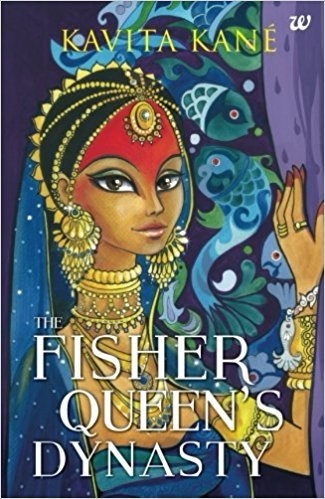Human life is filled with contradiction. Whether one should live a simple life by sticking to morals or should one rise in the social ladder through deceit and manipulation? This classic question has been a matter of debate not only in public life but also inside the minds of individuals. The book ‘The Fisher Queen’s Dynasty‘ by Kavita Kané captures this dilemma through the character of Satyavati, the fisher-girl who went on to become a queen.

The book starts with the scene of Bhishm lying on his bed of arrows, contemplating about his life and mistakes. He wonders whether he could have avoided the mistakes he had done in the past. The rest of the story is presented as a flashback of Bhishm’ s life till Satyavati chooses to leave Hastinapur.
The story of Satyavati, Devvrat/Bhishm and Shantanu is well known. It is usually presented as a brief prelude to the great Indian epic Mahabharata to explain the birth of Pandu and Dhritarashtra. But the key role of Satyavati in the shaping the future of Hastinapur is not well known. Kavita Kané explores this story in depth.
The author’s characterization of Satyavati is commendable. She is able to capture her beauty, ambition, vulnerability and sorrow in the course of the book. I must credit the author for exposing the raw ambition of Satyavati through this dialogue :
“It is better I use my ambitions wisely. I would rather make use of a powerful man and get some benefits, as I have done with Rishi Parashar. If it is looks and lust which can seduce a man, weaken him, then I shall employ them as my means; I shall use my charms to get what I want. I cannot afford to have morals like the rich and the royal. The righteous would argue that it is unscrupulous, but I would rather be branded that, than be forgotten as a casualty, as my mother was. If men can use women, why can’t women get something out of men? Beauty and lust is just that- a means to an end”
The author has also explored the subject of sensuality in her book. The progress of Shantanu and Satyavati’s relationship, the high drama of their relationship is brought out well in her book. It appears that the concept of beauty in those times was not tied to the color of skin. The description of her body by the author brings her alive in front of the reader’s eyes :
She was very tall and sculpted, with the strength to manoeuvre the wooden boat in the choppy waters. She was dusky and ravishing with broad shoulders, a provocative bust, a small waist, voluptuous hips and long legs which were taut and tense swaying with the movement of the boat as the fabric of her short cloth rode up her smooth thighs. Her thick dark hair rested loosely on her bare shoulders.
Domestic squabbles prior to the marriage of Shantanu and Satyavati, the reluctance of the palace and people to accept her as a queen and her ability to endure it all have been dealt in great detail. The story doesn’t move as fast as it does in the first half of the book in the second half. But it delves deeper into the complexities of royal life and inner contradictions of Satyavati and Bhishm.
The trajectory of the story moves in line with the rise and fall of Satyavati’s fortunes and Bhishm’s sense of idealism. It also explores the tension between Satyavati and her progeny. This tension is similar to the one experienced by Bhishm and his version of idealism. It evokes the reader to appreciate these tensions though there may not be any standard answers to solve them.
The book is a beautiful exploration of human contradictions. The fallout of these contradictions leads to disaster for the royal family of Hastinapur. A replication of the same may not be rare in modern day as well. And therefore, it is a book worth the time of any keen reader.



